Me at Sisslinghurst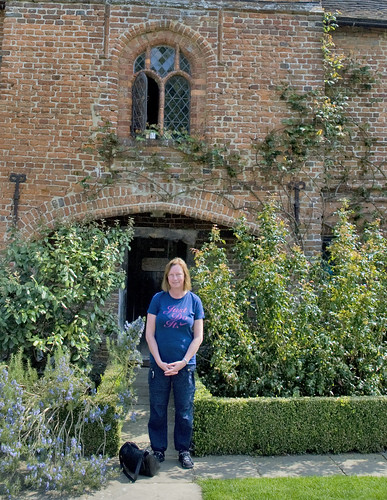
Image by Ben124.
Sissinghurst Castle National Trust
Sissinghurst's garden was created in the 1930s by Vita Sackville-West, poet and gardening writer, and her husband. Sissinghurst's garden is one of the best-loved in the whole of the United Kingdom, drawing visitors from all over the world. The garden itself is designed as a series of "rooms", each with a different character of colour and/or theme, the walls being high clipped hedges and many pink brick walls.
The site is ancient— "hurst" is the Saxon term for "an enclosed wood". A manorhouse with a three-armed moat was built here in the Middle Ages.By 1305, Sissinghurst was impressive enough for King Edward I to spend the night. In 1490, Thomas Baker purchased Sissinghurst.[2] The house was given a new brick gatehouse in the 1530s by Sir John Baker, one of Henry VIII's Privy Councillors, and hugely enlarged in the 1560s by his son Sir Richard Baker, when it became the centre of a 700-acre (2.8 km2) deer park. In 1573, Queen Elizabeth I spent three nights at Sissinghurst.[2]
For Sackville-West, Sissinghurst and its garden rooms came to be a poignant and romantic substitute for Knole, reputedly the largest house in Britain, which as the only child of Lionel, the 3rd Lord Sackville she would have inherited had she been a male, but which had passed to her uncle as the male heir.
Rose arbor in Sissinghurst's White garden room, which set a fashion for "white gardens"
After the collapse of the Baker family in the late 17th century, the building had many uses: as a prisoner-of-war camp during the Seven Years' War; as the workhouse for the Cranbrook Union; after which it became homes for farm labourers.
Sackville-West and Nicolson found Sissinghurst in 1930 after concern that their property Long Barn, near Sevenoaks, Kent, was close to development over which they had no control. Although Sissinghurst was derelict, they purchased the ruins and the farm around it and began constructing the garden we know today. The layout by Nicolson and planting by Sackville-West were both strongly influenced by the gardens of:
Today
The National Trust took over the whole of Sissinghurst, its garden, farm and buildings, in 1967. The garden epitomises the English garden of the mid-20th century. It is now very popular and hence can be very crowded in peak holiday periods. In 2009 BBC Four broadcast an eight-part television documentary series called Sissinghurst. It describes the house and garden and the attempts by Adam Nicolson and his wife Sarah Raven, who are Resident Donors, in partnership with the National Trust, to restore a form of traditional Wealden agriculture to the Castle Farm. Their plan is to use the land to grow ingredients for lunches in the Sissinghurst restaurant. A fuller version of the same story can be found in Nicolson's book, Sissinghurst: An Unfinished History (2008).
Allen at Sisslinghurst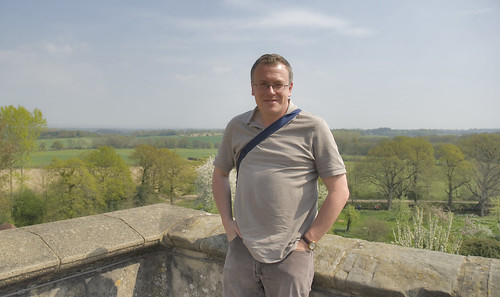
Image by Ben124.
Sissinghurst Castle National Trust
Sissinghurst's garden was created in the 1930s by Vita Sackville-West, poet and gardening writer, and her husband. Sissinghurst's garden is one of the best-loved in the whole of the United Kingdom, drawing visitors from all over the world. The garden itself is designed as a series of "rooms", each with a different character of colour and/or theme, the walls being high clipped hedges and many pink brick walls.
The site is ancient— "hurst" is the Saxon term for "an enclosed wood". A manorhouse with a three-armed moat was built here in the Middle Ages.By 1305, Sissinghurst was impressive enough for King Edward I to spend the night. In 1490, Thomas Baker purchased Sissinghurst.[2] The house was given a new brick gatehouse in the 1530s by Sir John Baker, one of Henry VIII's Privy Councillors, and hugely enlarged in the 1560s by his son Sir Richard Baker, when it became the centre of a 700-acre (2.8 km2) deer park. In 1573, Queen Elizabeth I spent three nights at Sissinghurst.[2]
For Sackville-West, Sissinghurst and its garden rooms came to be a poignant and romantic substitute for Knole, reputedly the largest house in Britain, which as the only child of Lionel, the 3rd Lord Sackville she would have inherited had she been a male, but which had passed to her uncle as the male heir.
Rose arbor in Sissinghurst's White garden room, which set a fashion for "white gardens"
After the collapse of the Baker family in the late 17th century, the building had many uses: as a prisoner-of-war camp during the Seven Years' War; as the workhouse for the Cranbrook Union; after which it became homes for farm labourers.
Sackville-West and Nicolson found Sissinghurst in 1930 after concern that their property Long Barn, near Sevenoaks, Kent, was close to development over which they had no control. Although Sissinghurst was derelict, they purchased the ruins and the farm around it and began constructing the garden we know today. The layout by Nicolson and planting by Sackville-West were both strongly influenced by the gardens of:
Today
The National Trust took over the whole of Sissinghurst, its garden, farm and buildings, in 1967. The garden epitomises the English garden of the mid-20th century. It is now very popular and hence can be very crowded in peak holiday periods. In 2009 BBC Four broadcast an eight-part television documentary series called Sissinghurst. It describes the house and garden and the attempts by Adam Nicolson and his wife Sarah Raven, who are Resident Donors, in partnership with the National Trust, to restore a form of traditional Wealden agriculture to the Castle Farm. Their plan is to use the land to grow ingredients for lunches in the Sissinghurst restaurant. A fuller version of the same story can be found in Nicolson's book, Sissinghurst: An Unfinished History (2008).
View from the tower Sisslinghurst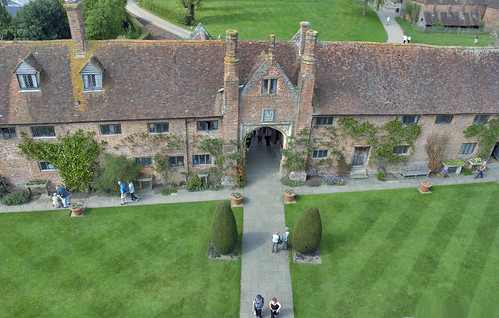
Image by Ben124.
Sissinghurst Castle National Trust
Sissinghurst's garden was created in the 1930s by Vita Sackville-West, poet and gardening writer, and her husband. Sissinghurst's garden is one of the best-loved in the whole of the United Kingdom, drawing visitors from all over the world. The garden itself is designed as a series of "rooms", each with a different character of colour and/or theme, the walls being high clipped hedges and many pink brick walls.
The site is ancient— "hurst" is the Saxon term for "an enclosed wood". A manorhouse with a three-armed moat was built here in the Middle Ages.By 1305, Sissinghurst was impressive enough for King Edward I to spend the night. In 1490, Thomas Baker purchased Sissinghurst.[2] The house was given a new brick gatehouse in the 1530s by Sir John Baker, one of Henry VIII's Privy Councillors, and hugely enlarged in the 1560s by his son Sir Richard Baker, when it became the centre of a 700-acre (2.8 km2) deer park. In 1573, Queen Elizabeth I spent three nights at Sissinghurst.[2]
For Sackville-West, Sissinghurst and its garden rooms came to be a poignant and romantic substitute for Knole, reputedly the largest house in Britain, which as the only child of Lionel, the 3rd Lord Sackville she would have inherited had she been a male, but which had passed to her uncle as the male heir.
Rose arbor in Sissinghurst's White garden room, which set a fashion for "white gardens"
After the collapse of the Baker family in the late 17th century, the building had many uses: as a prisoner-of-war camp during the Seven Years' War; as the workhouse for the Cranbrook Union; after which it became homes for farm labourers.
Sackville-West and Nicolson found Sissinghurst in 1930 after concern that their property Long Barn, near Sevenoaks, Kent, was close to development over which they had no control. Although Sissinghurst was derelict, they purchased the ruins and the farm around it and began constructing the garden we know today. The layout by Nicolson and planting by Sackville-West were both strongly influenced by the gardens of:
Today
The National Trust took over the whole of Sissinghurst, its garden, farm and buildings, in 1967. The garden epitomises the English garden of the mid-20th century. It is now very popular and hence can be very crowded in peak holiday periods. In 2009 BBC Four broadcast an eight-part television documentary series called Sissinghurst. It describes the house and garden and the attempts by Adam Nicolson and his wife Sarah Raven, who are Resident Donors, in partnership with the National Trust, to restore a form of traditional Wealden agriculture to the Castle Farm. Their plan is to use the land to grow ingredients for lunches in the Sissinghurst restaurant. A fuller version of the same story can be found in Nicolson's book, Sissinghurst: An Unfinished History (2008).
Me at Sisslinghurst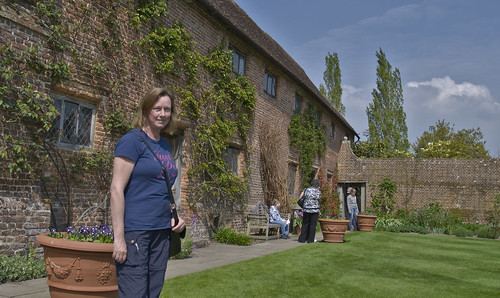
Image by Ben124.
Sissinghurst Castle National Trust
Sissinghurst's garden was created in the 1930s by Vita Sackville-West, poet and gardening writer, and her husband. Sissinghurst's garden is one of the best-loved in the whole of the United Kingdom, drawing visitors from all over the world. The garden itself is designed as a series of "rooms", each with a different character of colour and/or theme, the walls being high clipped hedges and many pink brick walls.
The site is ancient— "hurst" is the Saxon term for "an enclosed wood". A manorhouse with a three-armed moat was built here in the Middle Ages.By 1305, Sissinghurst was impressive enough for King Edward I to spend the night. In 1490, Thomas Baker purchased Sissinghurst.[2] The house was given a new brick gatehouse in the 1530s by Sir John Baker, one of Henry VIII's Privy Councillors, and hugely enlarged in the 1560s by his son Sir Richard Baker, when it became the centre of a 700-acre (2.8 km2) deer park. In 1573, Queen Elizabeth I spent three nights at Sissinghurst.[2]
For Sackville-West, Sissinghurst and its garden rooms came to be a poignant and romantic substitute for Knole, reputedly the largest house in Britain, which as the only child of Lionel, the 3rd Lord Sackville she would have inherited had she been a male, but which had passed to her uncle as the male heir.
Rose arbor in Sissinghurst's White garden room, which set a fashion for "white gardens"
After the collapse of the Baker family in the late 17th century, the building had many uses: as a prisoner-of-war camp during the Seven Years' War; as the workhouse for the Cranbrook Union; after which it became homes for farm labourers.
Sackville-West and Nicolson found Sissinghurst in 1930 after concern that their property Long Barn, near Sevenoaks, Kent, was close to development over which they had no control. Although Sissinghurst was derelict, they purchased the ruins and the farm around it and began constructing the garden we know today. The layout by Nicolson and planting by Sackville-West were both strongly influenced by the gardens of:
Today
The National Trust took over the whole of Sissinghurst, its garden, farm and buildings, in 1967. The garden epitomises the English garden of the mid-20th century. It is now very popular and hence can be very crowded in peak holiday periods. In 2009 BBC Four broadcast an eight-part television documentary series called Sissinghurst. It describes the house and garden and the attempts by Adam Nicolson and his wife Sarah Raven, who are Resident Donors, in partnership with the National Trust, to restore a form of traditional Wealden agriculture to the Castle Farm. Their plan is to use the land to grow ingredients for lunches in the Sissinghurst restaurant. A fuller version of the same story can be found in Nicolson's book, Sissinghurst: An Unfinished History (2008).
Sisslinghurst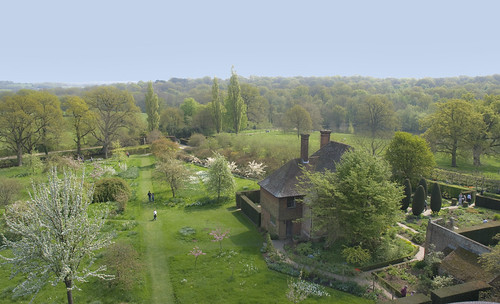
Image by Ben124.
Sissinghurst Castle National Trust
Sissinghurst's garden was created in the 1930s by Vita Sackville-West, poet and gardening writer, and her husband. Sissinghurst's garden is one of the best-loved in the whole of the United Kingdom, drawing visitors from all over the world. The garden itself is designed as a series of "rooms", each with a different character of colour and/or theme, the walls being high clipped hedges and many pink brick walls.
The site is ancient— "hurst" is the Saxon term for "an enclosed wood". A manorhouse with a three-armed moat was built here in the Middle Ages.By 1305, Sissinghurst was impressive enough for King Edward I to spend the night. In 1490, Thomas Baker purchased Sissinghurst.[2] The house was given a new brick gatehouse in the 1530s by Sir John Baker, one of Henry VIII's Privy Councillors, and hugely enlarged in the 1560s by his son Sir Richard Baker, when it became the centre of a 700-acre (2.8 km2) deer park. In 1573, Queen Elizabeth I spent three nights at Sissinghurst.[2]
For Sackville-West, Sissinghurst and its garden rooms came to be a poignant and romantic substitute for Knole, reputedly the largest house in Britain, which as the only child of Lionel, the 3rd Lord Sackville she would have inherited had she been a male, but which had passed to her uncle as the male heir.
Rose arbor in Sissinghurst's White garden room, which set a fashion for "white gardens"
After the collapse of the Baker family in the late 17th century, the building had many uses: as a prisoner-of-war camp during the Seven Years' War; as the workhouse for the Cranbrook Union; after which it became homes for farm labourers.
Sackville-West and Nicolson found Sissinghurst in 1930 after concern that their property Long Barn, near Sevenoaks, Kent, was close to development over which they had no control. Although Sissinghurst was derelict, they purchased the ruins and the farm around it and began constructing the garden we know today. The layout by Nicolson and planting by Sackville-West were both strongly influenced by the gardens of:
Today
The National Trust took over the whole of Sissinghurst, its garden, farm and buildings, in 1967. The garden epitomises the English garden of the mid-20th century. It is now very popular and hence can be very crowded in peak holiday periods. In 2009 BBC Four broadcast an eight-part television documentary series called Sissinghurst. It describes the house and garden and the attempts by Adam Nicolson and his wife Sarah Raven, who are Resident Donors, in partnership with the National Trust, to restore a form of traditional Wealden agriculture to the Castle Farm. Their plan is to use the land to grow ingredients for lunches in the Sissinghurst restaurant. A fuller version of the same story can be found in Nicolson's book, Sissinghurst: An Unfinished History (2008).
No comments:
Post a Comment